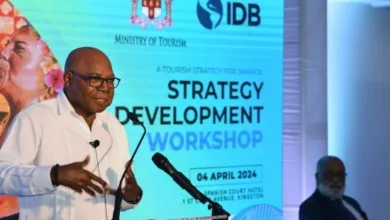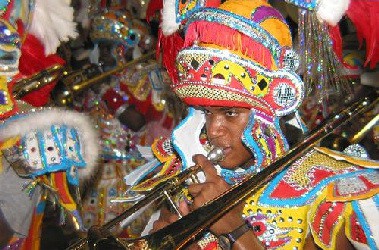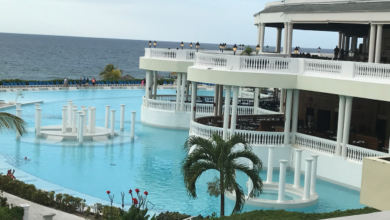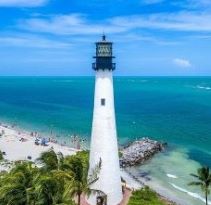Grand Bahama Island needs new cruise terminal, reduction in airport fees to fuel tourism growth
FREEPORT – The high cost associated with aircraft utilizing the privately owned Grand Bahama Airport, and the need for a new cruise ship harbor were among key areas singled out by a senior tourism official as helping to impede the growth of tourism on Grand Bahama.
Mr. David Johnson, Deputy Director General at the Bahamas Ministry of Tourism made those observations as he addressed the Eighth Annual Grand Bahama Business Outlook Seminar at the Our Lucaya Resort on Tuesday. He told participants that Grand Bahama was operating with several handicap and that he believe that we should take swift measures to fix it.
Mr. Johnson told the his audience that Grand Bahama has one of the highest airport turn around cost within the region, and when compares to Nassau is some $34 per passengers more. To illustrate he said, “what that means is that on a 50 seat aircraft with average loads of 75%, Grand Bahama’s cost is $1,275.00 more to turn around a Dash 8 like Bahamasair than in New Providence”.
To illustrate further he noted, “on a jet with a 125-seat capacity; with a 75% load factor, Grand Bahama cost $3,187.00 more per turn around, or well over $1 million per year if the aircraft operated a daily service”.
To give participants a further appreciation for his comments, Mr. Johnson noted that in July 2005, Miami International Airport’s traffic grew only by 2% from 1,389,298 passengers to 1,423,313 passengers. On the other hand, Fort Lauderdale’s traffic grew by more than 200% for the same month from 319,849 to 953,129.
According to Mr. Johnson a significant number of the Ft. Lauderdale passengers are persons who live in Dade County, but chose to save money by using Ft. Lauderdale for cheaper flights on the growing number of airlines which avoid flying into high cost airports.
He noted that if Miami did not have the European and South American long haul network, they would be out of business today competing with Ft. Lauderdale for domestic flights, or they would be forced to drop their cost in order to regain their share of the pie.
“In the same way, unless Grand Bahama begins to offer competitive airport turn around cost, we will be hard pressed to stay in business, much less pursue any growth strategies,” he said.
He told the audience, that included Grand Bahama Port Authority officials, owner of the airport, that customers really don’t care to know and will not research the reason for the high costs, and that they will simply choose other more attractive options.
Additionally, he revealed that Jetblue and Spirit Airlines refuse to operate flights to Miami for reasons related to cost and in the same way, will not consider serving Grand Bahama Island, in addition to several other considerations.
Further, Mr. Johnson also touched on the high cost of fuel and advised that Air Tran and US Airways the two most important jet carriers servicing Grand Bahama are faced with a combined increase in their flight cost of some $10 million, driven largely by fuel cost and compounded by our much higher turn around charges.
“Our best weapon is to seek out ways to lower costs in the areas we can, even if it can be linked to volume.
“Today, there is no incentive in Grand Bahama Island for an airline to add capacity in the hopes of lowering unit costs, which is often the incentive in most locations. We must find ways to compete. Others are doing this,” he said.
Mr. Johnson did not lay complete blame on the Grand Bahama Port Authority, or the Government, as he explained that the airport cost are driven by a combination of well above average cost, driven by the airport facility, the handlers and high Customs and Immigration overtime charges that does not exist elsewhere in our region.
He pointed out that taxes on tickets to the United States from Grand Bahama is now $104 per person, while the airfare in often no more than $100, and sometimes less. In Nassau the cost according to the speaker, is pegged at $69.
“We must fix this to get where we wish to go with successfully redeveloping our tourism sector,” he said.
On the subject of Cruise Tourism, Mr. Johnson said that this area has been consistently half of Grand Bahama’s tourism arrivals over the past 15 years, and that this has occurred with a far less than ideal cruise port.
“We are encouraging the development of a state of the art new passenger cruise facility for Grand Bahama that would, after its completion, result in cruise arrivals swiftly reaching the 1.5 million mark from the existing 400,000 we are achieving today,” he stated.
Mr. Johnson feels that a new cruise port will inject approximately $100 million per annum in tourist expenditures in the island’s economy. Likewise he said that critical to the rejuvenation of Grand Bahama’s tourism sector in the short term is the redevelopment of the closed Royal Oasis Resort and Casino and also the redevelopment of the adjacent International Bazaar.
“We have not been closer than we are today, and I know that the players we are engaging to take on can deliver,” he said about the possible sale of the property.
According to Mr. Johnson, the firm “has the market leverage and credibility and is financially prepared to truly redevelop and reposition, and not only come with paint and wall paper.
“We need much more than simply having the 1000 rooms back in play, we need a new and vibrant spirit that a world class operator will bring to this section of the island.
“In tandem with the redevelopment of the Royal Oasis and International Bazaar will be a focused to bring back night life, especially native entertainment to Grand Bahama’s main stage,” he said.
Mr. Johnson made it clear that that is the mandate of the Ministry of Tourism and that they have already mobilized the team and are putting in place the resources to cause that to happen.
He said that he expects to see a complete recovery in Grand Bahama’s tourism arrivals by the winter of 2007.




